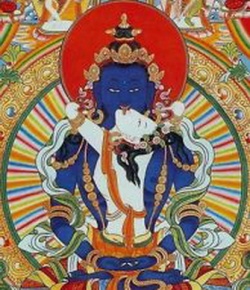Generation stage
In Tantric Buddhism, the generation stage (T:kye rim, Wyl., bskyed rim; S:utpatti-krama) is the first phase of meditative Buddhist sādhana associated with the 'Father Tantra' (Wylie: pha-rgyud; pa-rgyud) class of anuttara-yoga-tantras of the Sarmapa or associated with what is known as Mahayoga Tantras by the Nyingmapa. An example of a 'Father Tantra' is the Guhyasamāja Tantra.
The generation stage engages creative imagination or visualization as an upaya or skillful means of personal transformation through which the practitioner (sadhaka) either visualizes a meditational deity (yidam) or refuge tree before themselves in front generation, or as themselves in self generation, to engender an alteration to their perception and/or experience of the appearance aspect of reality.
The complement of the generation/development/creation stage is the completion stage (T:dzog rim, Wyl. rdzogs rim; S:saṃpanna-krama).
The generation stage is a method of vajrayana practice that focuses on purifying our ordinary dualistic relationship with taking birth in this world and the experience of this life. Through the methods of clear visualization, pure recollection of the deeper meanings of the symbolic attributes of the deities, and cultivating stable confidence in ourselves and the universe ultimately being the infinite pure mandala filled with infinite varieties of enlightened deities, we come to realize that the universe and its inhabitants have ultimately been pure expressions of enlightenment from the very beginning. Here you will find a variety of methods to accomplish this.
Bhagavati Vajrayogini with Faces of the Two Truths by Rigdzin Chokyi Dragpa
This is a concise and classic sadhana by Rigdzin Chökyi Dragpa (1595-1659) used to meditate upon oneself and the universe as Vajrayogini. It is the main sadhana used by countless yogis and yoginis for hundreds of years in the Drigung Kagyü retreat practice of the Six Dharmas of Naropa. It is part of a longer commentary on the Six Dharmas of Naropa that will be published in the near future. (10 pages)
Meditation on the Three-Layered Protection Wheel of Chandali by Jigten Sumgon
This sadhana, composed by Jigten Sumgön (1143-1217), contains the practices of Avalokitesharva, the wrathful deity Achala, and Vajrayogini woven into one. It is designed to be practiced when doing the practices of chandali (tummo or inner fire meditation). (4 pages)
Blazing Light Rays of Great Bliss – Peaceful Fire Puja for Jetsun Vajrayogini by Orgyen Nuden Dorje
This is a sadhana composed by Orgyen Nüden Dorje (1849-1902) to engage in the purifying peaceful fire offering that traditionally comes at the end of Vajrayogini practice and retreat. Unlike elaborate fire puja rituals which require many hard to find substances and such, this practice utilizes the support of a single substance (black sesame seeds) and fire. (9 pages)
A Piece of the Profound Secret Enlightened Mind Secret Vajravarahi Sadhana by Orgyen Nuden Dorje
This is a sadhana compiled by Orgyen Nüden Dorje to practice the Vajravarahi treasure practice that was revealed by Rinchen Phüntshog in his Yangzab terma cycle. This sadhana presents Vajravarahi practice from the perspective of Atiyoga or Dzogchen. There are two other sadhanas that go along with the root terma text, presenting the practice of Vajravarahi from the perspectives of maha and anu yoga. (6 pages)
Fulfilling the Wish for Accomplishment Chakrasamvara Sadhana by Orgyen Nuden Dorje
This is a concise sadhana for the practice of the Ghantapa’s tradition of Coemergent Chakrasamvara and Vajrayogini in union. (6 pages)
Red Kurukulle Sadhana by Rigdzin Chokyi Dragpa
This is a sadhana focused on the magnetizing and attracting activity deity, Red Kurukulle. (7 pages)
Padmakara and Mandarava Amitayus Practice of Immortal Life by Rigdzin Chokyi Dragpa
This is a special long-life practice based on the root texts revealed by Rinchen Phüntshog in his Yangzab terma cycle. (11 pages)
Chö Body Offering by Orgyen Nuden Dorje
This is a powerful and clear rendition of the practice of Chö, or “Severence”. Nuden Dorje presents this practice, which can be traced back to the great dakini Machig Labdrön (11th century) in a manner that contains the white feast, red feast, and black feast. In the process of Chö, one offers all aspects of oneself to the four types of guests as a feast to train in limitless compassion and the realization of selfless emptiness. (21 pages)
Jambhala (Dzambhala) Sadhana by Rigdzin Chokyi Dragpa
This is a sadhana focused on the deity of infinite generosity and prosperity, Jambhala. (7 pages)
Sadhana of Ushnisha Vijaya (Namgyalma) by Rigdzin Chokyi Dragpa
This is a sadhana focused on Ushnisha Vijaya, a goddess that emanated from the crown protuberance of the Buddha Shakyamuni to protect beings from the lower realms and suffering.
Front generation
Front generation is a form of meditative visualization employed in Tantric Buddhism in which the yidam is visualized as being present in the sky facing the practitioner as opposed to the self-identification that occurs in self generation. According to the Vajrayana tradition, this approach is considered less advanced, hence safer for the sadhaka, and is engaged more for the rites of propitiation and worship.
Self generation
Self generation is a form of meditative visualization employed in Tantric Buddhism in which the yidam is invoked and then merged with the sadhaka as an upaya of self-transformation. This is as opposed to the method of front generation. According to the Vajrayana tradition, self generation is held to be more advanced and accompanied by a degree of spiritual risk from the siddhi it may rapidly yield.
